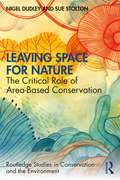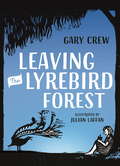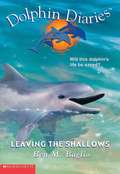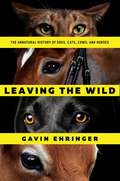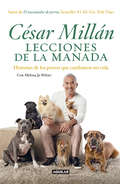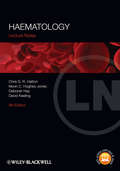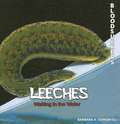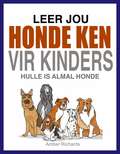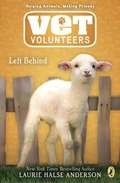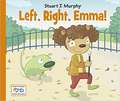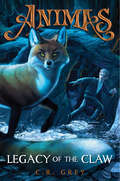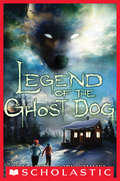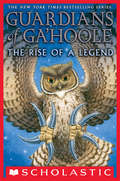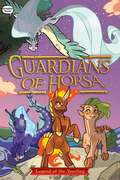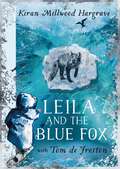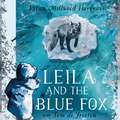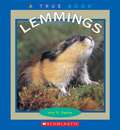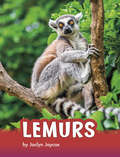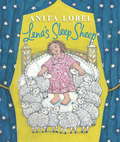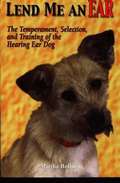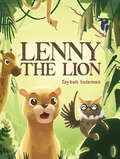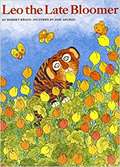- Table View
- List View
Leaving Space for Nature: The Critical Role of Area-Based Conservation (Routledge Studies in Conservation and the Environment)
by Nigel Dudley Sue StoltonThis book provides the first contemporary assessment of area-based conservation and its implications for nature and society. Now covering 15 per cent of the land surface and a growing area of ocean, the creation of protected areas is one of the fastest conscious changes in land management in history. But this has come at a cost, including a backlash from human rights organisations about the social impacts of protected areas. At the same time, a range of new types of area-based conservation has emerged, based on indigenous people’s territories, local community lands and a new designation of “other effective area-based conservation measures”. This book provides a concise overview of the status and possible futures of area-based conservation. With many people calling for half the earth’s land surface to remain in a natural condition, this book taps into the urgent debate about the feasibility of such an aim and the ways in which such land might be managed. It provides a timely contribution by people who have been at the centre of the debate for the last twenty years. Building on the authors’ large personal knowledge, the book draws on global case studies where the authors have firsthand experience, including Yosemite National Park (USA), Blue Mountains National Park (Australia), Bwindi National Park (Uganda), Chingaza National Park (Colombia), Ustyart Plateau (Kazakhstan), Snowdonia National Park (Wales) and many more. This book is essential reading for students, academics and practitioners interested in conservation and its impact on society.
Leaving Time: the impossible-to-forget story with a twist you won't see coming by the number one bestselling author of A Spark of Light
by Jodi PicoultJenna Metcalf was with her mother the night she disappeared in tragic and mysterious circumstances, but she remembers nothing.Over ten years have passed, and still Jenna reads and rereads her mother's journals, hoping to find some clue hidden there, in the meticulous recording of her scientific research with elephants. Desperate for answers, Jenna uses all her savings to recruit the aid of a private detective - and a psychic.Jenna knows her mother loved her. She knows she would not leave her. And she will not rest until she finds out what happened that night. In her most gripping mystery since House Rules, Jodi Picoult brings us a powerful story of a young girl's determination to uncover the truth, however shocking and life-changing it might be.(P)2014 Random House Audio
Leaving the Lyrebird Forest
by Gary Crew Julian Laffan'Are you lonely here?' her mother asked. 'Never,' Alice said. 'Not while I am friends with the lyrebird.'Alice has spent her life living on the outskirts of a small town, in a house nestled in bushland. Every other morning, she is visited by a lyrebird. Her bond with this magnificent bird brings her together with her nearest neighbour, Mr Brown, a widower who loves the bush and its treasures as much as she does.But change is coming: Alice is growing up, and having to think about her future (a future which might mean leaving the bush for her education). Mr Brown is getting older, and less able to look after himself. And as the nearby town grows, their beloved lyrebird and bushland are threatened too.A touching story that will resonate with readers everywhere, stunningly illustrated with woodcuts by acclaimed artist Julian Laffan.
Leaving the Shallows (The Dolphin Diaries #9)
by Ben M. BaglioAfter weeks at sea, Jody and her family have arrived at Hervey Bay, off the coast of Australia. There, Jody befriends a gorgeous pink-and-white dolphin named Dawn. Jody notices a neighboring tourist operation isn't keeping the dolphins' interests in mind and, as a result, Dawn becomes ill. Will Jody be able to convince them to change their ways before it's too late?
Leaving the Wild: The Unnatural History Of Dogs, Cats, Cows, And Horses
by Gavin EhringerA thought-provoking and surprising book that explores the ever-evolving relationship between humans and domesticated animals. The domestication of animals changed the course of human history. But what about the animals who abandoned their wild existence in exchange for our care and protection? Domestication has proven to be a wildly successful survival strategy. But this success has not been without its drawbacks. A modern dairy cow’s daily energy output equals that of a Tour de France rider. Feral cats overpopulate urban areas. And our methods of breeding horses and dogs have resulted in debilitating and sometimes lethal genetic diseases. But these problems and more can be addressed, if we have the will and the compassion. Human values and choices determine an animal’s lot in life even before he or she is born. Just as a sculptor’s hands shape clay, so human values shape our animals—for good and or ill. The little-examined, yet omnipresent act of breeding lies at the core of Gavin Ehringer's eye-opening book. You’ll meet cows cloned from steaks, a Quarter horse stallion valued at $7.5 million, Chinese dogs that glow in the dark, and visit a Denver cat show featuring naked cats and other cuddly mutants. Is this what the animals bargained for all those millennia ago, when they first joined us by the fire?
Lecciones de la manada: Historias de los perros que cambiaron mi vida
by Melissa Jo Peltier César MillánCésar Millán, el experto en comportamiento canino, revela las distintas maneras en que el mejor amigo del hombre se convierte también en nuestro mayor maestro. De César Millán, autor de El encantador de perros, bestseller #1 del New York Times. En esta narrativa íntima, escrita con el corazón, César Millán, autor de bestsellers y reconocido experto en comportamiento canino, aborda su filosofía sobre el cuidado de las mascotas desde una nueva perspectiva: el efecto positivo que tiene en los dueños. César comparte, por primera vez, historias personales acerca de muchos de los increíbles perros que le han brindado lecciones fundamentales de vida. Estos relatos tratan temas que van desde el respeto y la resiliencia, hasta la confianza y la autenticidad. Las cálidas vivencias de César vienen acompañadas de reflexiones de varios de sus célebres clientes, como Kesha, Whitney Cummings y Jada Pinkett Smith, y revelan la manera en que las relaciones entre los humanos y los perros pueden ayudarnos a que surja lo mejor de nosotros. Con la ayuda de ocho perros excepcionales -desde Paloma, el mestizo que le enseña a nuestro experto el significado del respeto, en el rancho de su abuelo en México; a su adorado secuaz Daddy, un pit bull, epítome de la sabiduría-, nos guía en un viaje emocional a través de su vida y nos explica las lecciones que ha aprendido gracias a su manada. Asimismo, ofrece a las legiones de propietarios de perros en todo el mundo, un original plan para alcanzar la felicidad y la realización personal a través de la camaradería canina.
Lecture Notes: Haematology
by Chris S.R. Hatton Deborah Hay David Keeling Nevin C. Hughes-JonesHaematology Lecture Notes is an accessible and concise best-selling study guide, outlining the physiology, pathology and treatment of the most common blood disorders. Extensively revised and updated to reflect the considerable advances in the understanding of the molecular biology and pathogenesis of haematological disorders, it provides the core knowledge required by all medical students and junior doctors.Key features include:New material on coagulation and transfusionExpanded coverage of haematopoiesisA complete update of all malignant haematology contentA brand new companion website at www.lecturenoteseries.com/haematology featuring interactive MCQs with feedback on each answer selected, chapter summaries and revision notes in PowerPoint and PDF formats, and all the figures from the book in PowerPoint formatWhether approaching haematology for the first time, or looking for a refresher, Haematology Lecture Notes will enable students and junior doctors to develop an understanding of both the basic science and clinical aspects of this specialty.
Leeches, Maggots, and Skulls: Curious Cures from History (Fountas & Pinnell Classroom, Guided Reading)
by Dave Smith Lynda JonesNIMAC-sourced textbook. EW! Imagine eating bedbugs to cure a cold. Or swallowing leeches to heal your swollen tonsils. History is full of odd cures like these. Travel back in time to learn about the sometimes-horrid history of healing.
Leeches: Waiting In The Water (Bloodsuckers Ser.)
by Barbara SomervillYoung readers will be fascinating as they learn how leeches suck the blood of other animals for nourishment. This engrossing book explores the habitats, hunting patterns, life cycles, and varieties of leeches.
Leer Jou Honde Ken (Vir Kinders)
by Amber RichardsHierdie is ‘n boek wat handel oor die veskillende honde rasse. Dit is ‘n e-boek vir jong kinders wat in honde belangstel. Tussen die ouderdomme van 3 en 4 jaar is kinders geneig om die grammatikale reëls van hulle taal te oorveralgemeen. Hulle is geneig om voorwerpe met dieselfde eienskappe as dieselfde voorwerp te klassifiseer. Hierdie boek sal kinders help om te verstaan dat verskillende tipe honde, verkillende rasname het! Die boek bevat 21 verskillende foto's van bekende, sowel as meer onbekende honde rasse. Hierdie is ‘n prettige en leersame boek vir ouers om vir hulle vroeë lesers te lees, of selfs vir jong kinders om self te lees. Hierdie boek kan maklik 'n gesinsgunsteling word. Berei Berei julle snaakste en beste hondgeluide voor!
Left Behind
by Laurie Halse AndersonAnother moving installment in Laurie Halse Anderson's award-winning Vet Volunteers series!When Sunita joins Dr. Gabe and another Vet Volunteer on a house call at a local horse farm, she is concerned to discover a lone lamb housed in one of the stalls. She knows that sheep are flock animals, and that without other sheep and lambs around, this little lamb will not thrive. Can she and her fellow Vet Volunteers help educate the owner, and find a new home for it with others of its kind?
Left Right Emma! (I See I Learn #9)
by Stuart J. MurphyAfter learning the concept of left and right, Emma leads the class marching band on Grandparents Day.
Legacy of the Claw (Animas #1)
by C. R. GreyTo twelve-year-old Bailey Walker, kin means more than just family. It means being a part of the Animas bond, a harmonious link that connects humans and animals, and guides everything in his world. But Bailey hasn't found his kin yet, and without an Animas, he's destined to be an outsider???or worse, lose his mind entirely. So when he's accepted into the prestigious Fairmount Academy, he's determined to Awaken to his Animas once and for all, even if it's a measly worm. But once there, Bailey can't resist the pull of the dark mysteries surrounding the kingdom. A bear has been viciously attacked on school grounds, and when he and his friends discover signs of a ferocious predator in the woods surrounding campus, he knows something's out there, something dangerous. And Fairmount isn't the only place where darkness is brewing. In the capital city, a new leader preaches that humans must assert power over their kin, enslave them instead of living as one. Bailey can't shake the feeling that the root of the unrest, and the key to his Awakening, lies in an old riddle entwined around an even older prophecy???a prophecy that may reveal the truth about the rightful king of Aldermere. And Bailey may be the only one who can unravel them. The capital's dark forces will stop at nothing to prevent the prophecy from coming true. If they succeed, the Animas bond will be in peril. Can Bailey help protect the Animas bond while still trying to awaken to his own? In this first installment of the gripping ANIMAS series, the battle is just beginning.
Legend of the Ghost Dog
by Elizabeth Cody KimmelA thrilling mystery set against a stark landscape and the inspiration of Nome's real-life dog hero, Balto.Twelve-year-old Tee has just moved to Nome, Alaska, with her writer father and sullen little brother, Jack. Jack isn't happy about the idea of living in the middle of nowhere, but Tee and her dog Henry are thrilled -- so much open space to run around and sniff! But on a walk near their new house, Henry spots something that has him seriously spooked. Tee sees a mysterious shadow, and it seems to be following them. Have they disturbed a restless spirit? And what other secrets might this dark place be holding?
Legend of the Guardians: Legend of the Guardians (Guardians of Ga'Hoole)
by Kathryn LaskyGuardians of Ga'Hoole is a classic hero mythology about the fight between good and evil. This series is filled with adventure, suspense, and heart.When Soren, a young owlet, mysteriously falls from his nest one evening, he's plucked up and taken to the sinister St. Aegolius Academy for Orphaned Owls. Once there, he must use his wits and bravery to escape his captors.The first three books in the Ga'Hoole series follow Soren, Gylfie, Twilight, and Digger, four orphaned owls that must fight their way through many dangers to take refuge with a group of brave owls thought only to be a legend - the Guardians of Ga'Hoole!
Legend of the Yearling (Guardians of Horsa #1)
by Roan BlackIn the first installment of the action-packed Guardians of Horsa graphic novel series, four young horses from clashing herds must join forces to solve a mystery and save magic. <p><p> Welcome to the realm of Horsa, a world of magic, wild horses, and danger. The four elemental herds of Horsa live in uncertain peace, which is to say: stay out of each other’s way and all will be fine. But when signs of a mysterious prophecy about a yearling with untold magical powers appear, four young horses from each herd are called to action. Now these elemental enemies must work together to solve the prophecy, find the yearling, and restore balance to Horsa.
Leila and the Blue Fox
by Kiran Millwood Hargrave'A captivating tale that glistens with wonder. Leila and Fox will always have a home in my heart' Sophie Anderson'This is an extraordinary book - wild and beautiful and perfect. The mess and tangle of humanity is so brilliantly contrasted with the wild spirit of nature' Katya BalenCome with an Arctic fox on a breathtaking journey ... an enthralling story from the bestselling, award-winning creators of Julia and the Shark. With dazzling blue and black illustrations and presented as a deluxe hardback with tracing paper inserts, this is a perfect gift for 9+ fans of The Last Bear and A Wolf Called Wander.She was very tired.She lay down, her soft head on her soft paws.The sunset licked her face.The snow covered her like a blanket.Fox wakes, and begins to walk. She crosses ice and snow, over mountains and across frozen oceans, encountering bears and birds beneath the endless daylight of an Arctic summer, navigating a world that is vast, wild and wondrous. Meanwhile, Leila embarks on a journey of her own - finding her way to the mother who left her. On a breathtaking journey across the sea, Leila rediscovers herself and the mother she thought she'd lost, with help from a determined little fox.Based on the true story of an Arctic fox who walked from Norway to Canada in seventy-six days, a distance of two thousand miles, this compelling, emotional and beautifully illustrated story is the perfect gift for 9+ readers.Praise for Julia and the Shark:'A tale of courage, understanding and compassion' The Observer'Julia and the Shark is deep, beautiful and true. The art shines and the writing soars. A classic from cover to cover' Eoin Colfer'A truly beautiful book, with text and illustrations in perfect harmony. A book to treasure!' Jacqueline Wilson
Leila and the Blue Fox: The perfect gift for every child this Christmas! (Crookhaven #4)
by Kiran Millwood HargraveCome with an Arctic fox on a breathtaking journey ... an enthralling story from the bestselling, award-winning creators of Julia and the Shark. This is a perfect gift for 9+ fans of The Last Bear and A Wolf Called Wander.She was very tired.She lay down, her soft head on her soft paws.The sunset licked her face.The snow covered her like a blanket.Fox wakes, and begins to walk. She crosses ice and snow, over mountains and across frozen oceans, encountering bears and birds beneath the endless daylight of an Arctic summer, navigating a world that is vast, wild and wondrous.Meanwhile, Leila embarks on a journey of her own - finding her way to the mother who left her. On a breathtaking journey across the sea, Leila rediscovers herself and the mother she thought she'd lost, with help from a determined little fox.Based on the true story of an Arctic fox who walked from Norway to Canada in seventy-six days, a distance of two thousand miles, this compelling, emotional and beautifully illustrated story is the perfect gift for 9+ readers.Praise for Julia and the Shark:'A tale of courage, understanding and compassion' The Observer'Julia and the Shark is deep, beautiful and true. A classic from cover to cover' Eoin Colfer'A book to treasure!' Jacqueline Wilson(P) 2022 Hodder & Stoughton Limited
Lemmings (A True Book)
by Ann O. SquireHow do lemmings survive the long cold winters? What do they eat? And do they really run off cliffs? Find out the answers to these questions and many more in this fact filled book.
Lemurs (Animals)
by Jaclyn JaycoxLemurs are small, furry mammals with big eyes and long tails. Like humans, they are primates. These adorable animals settle their arguments with stink fights! Find out more about these curious creatures.
Lemurs (Nature's Children)
by Lorien KiteDescribes the physical features, habits and habitat of Lemurs. These creatures are native to Madagascar.
Lena's Sleep Sheep
by Anita LobelAfter a hug and kiss from Mama and Papa, Lena is cozy in her bed and ready for her sleep sheep to help her fall asleep. But the sheep refuse to line up and be counted!"We're sca-a-a-a-red!" the sheep baa together. "There's a round monster in the window, making faces at us. He looks hungry and ready for a sheep snack."Lena's sheep are afraid of the full moon shining through her window. Can clever Lena help these silly sheep overcome their fears so that she can get a good night's sleep?
Lend Me An Ear
by Martha HoffmanLend Me an ear is a remarkable book that helps one to evaluate the temperament of dogs- specifically shelter castaways for the purpose of training as hearing dogs. The book delves into temperaments that work and do not work along with providing instruction on how to train various skills needed for the dog to alert its partner.
Lenny the Lion
by Taybah SulemanA young lion cub embarks on a thrilling journey through the desert, safari, jungle and forest in hope to find his lion pack whilst meeting some fascinating animal friends along the way… Lenny the Lion is an enticing book teaching children the importance of resilience, overcoming obstacles and the value of friendship.
Leo the Late Bloomer
by Robert KrausLeo isn't reading, or writing, or drawing, or even speaking, and his father is concerned. But Leo's mother isn't. She knows her son will do all those things, and more, when he's ready.
